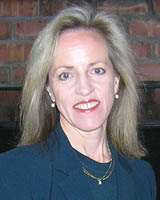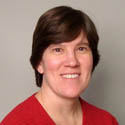|
On 25 and 26 October, 2011, the
Food and Drug Administration conducted a public workshop to
discuss the topic of MRI Safety. The meeting was held at the
FDA White Oak Campus in Silver Spring, Maryland, USA. The
public was invited to attend and to participate by giving
presentations during specific sessions and in roundtable
discussions. The purpose of the public workshop was “to
discuss factors affecting the safe use of magnetic resonance
imaging (MRI) and approaches to mitigate risks.” The overall
goal was “to discuss strategies to minimize patient and
staff risk in the MRI environment.” The topics discussed
included general MRI safety, ferromagnetic detectors,
scanning patients with medical implants, and the impact of
innovation on MRI safety concerns. The workshop was webcast
live and taped for later viewing by the public. |
|
AS:
Please tell us about your past experiences in MRI safety and
the work you do at the FDA's CDRH.
TW: I have been involved in the area of MRI safety at
FDA since the early 1990s, working to develop FDA guidance
as well as national and international standards addressing
the safety of medical devices in the MR environment. I am
the chair of the CDRH MR Working Group that is a cross
divisional group involving people from across CDRH to
address MRI safety issues in applications for new medical
devices and for issues involving devices that are on the
market. I initiated and chair the ASTM standards group that
has written and published 5 standards addressing testing and
labeling medical devices and other objects for safety in the
MR environment and participate in other IEC and ISO MRI
related standards groups.
AS: What was the motivation to hold this MRI safety
public workshop now or is it a regularly held meeting?
TW: The workshop is not a recurring meeting. We held
it to obtain feedback on a number of questions regarding
general MRI safe use and to identify areas where we can work
together to prevent very preventable accidents. We also held
the workshop to learn about the challenges that MR
Technologists and health care providers face with regard to
existing medical device labeling and their conditions of
use.
AS: How important is it to the FDA that in addition
to clinicians, scientists and those from industry that
technologists and radiographers attend these public
workshops on MRI safety? If so, why?
TW: We find your attendance critical. We need your
feedback because you are the individuals who are presented
with MR safety challenges in the field every day. You are
the front lines who ensure that patients are safely scanned
and that MR safety protocols are followed in your facility.
You are the ones who read medical device labeling every day
and you are the ones that have to make an immediate decision
about how that labeling impacts the proposed scan the
patient needs. It is important that we understand what
labeling information you need so that we can work with
device manufacturers to construct labeling that clearly
provides the information you need to determine if it is safe
to scan a patient with a given medical device.
AS: Among the many presentations that were given
during this two-day public workshop, were there any
surprises for you in the information that was shared?
TW: I was a little surprised to learn that many
audience members and workshop participants are unaware of
FDA’s regulatory authority. FDA regulates the medical device
industry. We do not regulate the practice of medicine, nor
do we require initial and ongoing education for clinical
staff. There were numerous comments indicating that FDA
should encourage or mandate ongoing education,
certification, and licensure for MR technologists and other
medical professionals as well as requests that we impose
requirements for accreditation and reimbursement, all of
which are outside the scope of FDA’s mission.
AS: Was there any information presented that supports
new directions in which you would like to see the FDA and
CDRH engage?
TW: For some time, I have wondered how useful MR
safety labeling is for medical professionals at MR sites. We
heard a request for more clear and consistent MR safety
labeling for implants and accessory devices and are
currently exploring different ways we can address that
concern. We are also working to improve MR safety education
for premarket reviewers at the FDA to ensure consistency in
reviews of medical device MR safety information. We are also
exploring ways we can reach out to MR professionals, other
health care providers, and hospital staff to increase their
awareness of the safety issues that may occur in the MRI
environment with the goal of preventing the many preventable
incidents that occur each year.
AS: There seemed to be a consensus among several of
the participating attendees that thermal burns and injuries
are the most common adverse events that occur during MRI
examinations. Do you agree with this and how do we work
towards reducing these incidents?
TW: I would like to emphasize that MRI is a very safe
imaging modality, with the majority of patients experiencing
no adverse events. Burns are an adverse event we continue to
see for a small minority of patients. I think having an
established MR safety program with well defined procedures
coupled with continuing education are the best ways to
minimize burns and other incidents, especially those that
result from incorrect positioning and padding techniques or
lapses in screening.
AS: The importance of continuing education for
technologists and radiographers as a means to reduce MR
safety incidents was emphasized by presenters and attendees.
Is there anything the FDA and CDRH can do to support this?
TW: As I mentioned earlier, continuing education is
not something for which FDA has jurisdiction. However, the
Agency recognizes the need to develop targeted education to
increase provider and patient awareness of the safety issues
that may occur in the MRI environment as it relates to
device use.
AS: Do you believe that the current MRI safety
labeling terminology (MR Unsafe, MR Conditional and MR safe)
will remain in its current form or change in the future to
be more specific with regards to items that may be affected
ferromagnetically or electrically?
TW: The current terms were developed over many years
with input from many parts of the MR community, including
the MR technologists who were polled to give their opinions
on possible terms and icons. We have been working since 2005
to spread awareness and use of these terms, and I do not
anticipate any changes in the current terms. I think we
should consider making more use of the optional
supplementary information sign that can be used with the MR
Conditional term and icon to provide additional information
about potential hazards like projectile hazards.
AS: How likely is it that the FDA and CDRH will seek
out continued dialogue and information from the SMRT going
forward?
TW: FDA welcomes input from our stakeholders. I think
it is critical that MR safety labeling be useful for MR
technologists and other MR professionals, so feedback from
the SMRT is very important to us as we continue to work with
the medical device manufacturers to construct MR Conditional
labeling.
AS: For many years now I have had the opportunity to
attend and participate in MRI Safety Workshops conducted by
the parent society of the SMRT, the ISMRM. I have been
impressed by the number of individuals from the FDA that are
in attendance at these meetings. What do you learn from
those workshops and how is it valuable to the FDA and the
CDRH?
TW: Since I spend most of my time working with
medical device manufacturers and my colleagues in CDRH, I
find the feedback from MR technologists and other members of
the clinical community on how things work ‘in the real
world’ to be invaluable. This helps us understand the
critical information that should be in MR safety labeling
and lets us know what technologists actually do with the
labeling. The workshops also provide a wonderful opportunity
to talk to other people in the MR safety community in a
neutral setting where we can proactively discuss the current
issues, hear possible solutions and learn about potential
issues.
(Note: ISMRM Safety Workshops are
typically conducted biennially. For more information, please
see
http://www.ismrm.org/meetings-workshops/future-ismrm-workshops/)
AS: Personally and professionally, I learned a great
deal during this two-day public workshop conducted in Silver
Spring, MD on MRI safety. If the SMRT hosted a similar
workshop inviting clinicians, scientists and industry, would
the FDA and CDRH think it valuable enough for you to attend?
TW: As a cost-saving measure, the government has
instituted travel restrictions. However, if funds were
available, I and others from the CDRH MR Working Group would
be eager to attend an SMRT workshop on MR safety.
In conclusion, thank you very much to Dr. Terry Woods from
the FDA's Center for Devices & Radiological Health for
taking the time from her busy schedule to speak to us. Given
her long history engaged in MRI safety, we are greatly
appreciative for sharing her thoughts and opinions regarding
the recent MRI safety public workshop and MR safety overall.
We believe that keeping the lines of communications not only
open but active; will ensure a safer MRI environment for
patients and health care professionals worldwide. |
|
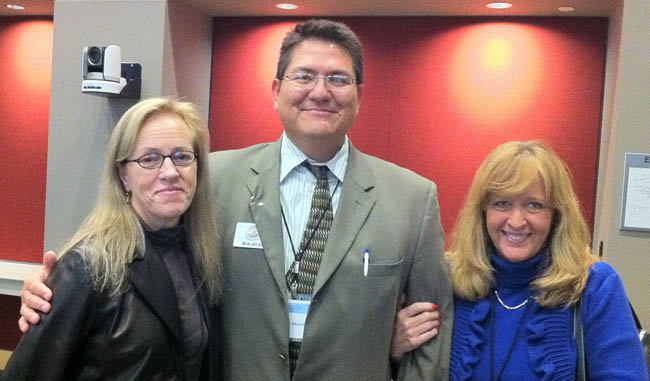
Anne Marie Sawyer, Charles
McIntyre, Carolyn Roth
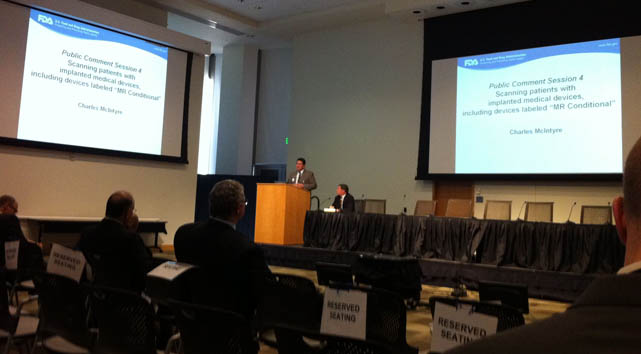
Charles McIntyre
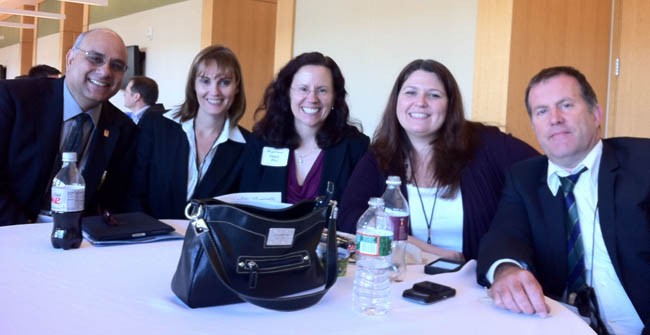
Ashok Saraswat, Vera Kimbrell, Maureen Hood, Sonja Boiteaux, Charles
Stanley
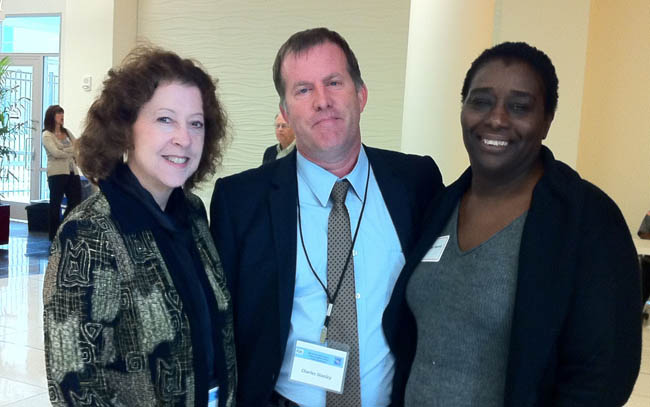
Ellen Lipman (ASRT), Charles Stanley, Christine Harris |

